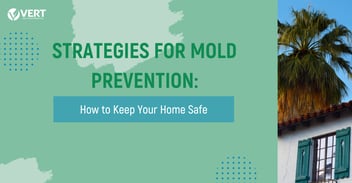Mold Prevention & Testing After Flooding
When floodwaters recede, they leave behind a silent intruder that can wreak havoc on your health and home—mold. Mold growth is a common aftermath of flooding, and if left unchecked, it can lead to a host of health issues and property damage. In this guide, we'll explore mold prevention and testing after flooding, providing you with the knowledge you need to protect your family and your living space.
Understanding Mold
Mold: The Unwanted Guest
Mold is a type of fungus that thrives in damp and humid environments. After flooding, the excess moisture creates an ideal breeding ground for mold. Understanding the basics of mold is essential:
Types of Mold:
- Mold comes in various types, including Aspergillus, Penicillium, and the notorious Stachybotrys, or black mold.
- Each type poses different health risks, with black mold being particularly concerning.
Conditions for Growth:
- Mold needs moisture, warmth, and organic materials (such as wood or drywall) to grow.
- Flooding provides the necessary moisture and warmth for mold to proliferate.
Signs of Mold Infestation
Recognizing the Culprit
Identifying mold in your home is crucial for timely intervention. Look out for these signs:
Visible Mold:
- Obvious mold growth on walls, ceilings, or other surfaces.
- Mold can appear in various colors, including black, green, or white.
Musty Odor:
- A distinct musty or earthy odor, often a sign of hidden mold.
- Investigate the source of the smell to uncover potential mold infestations.
Health Risks
The Health Toll
Mold exposure can have serious health consequences, especially for vulnerable individuals:
Respiratory Issues:
- Mold spores can trigger allergies and respiratory problems like coughing and wheezing.
- Those with asthma may experience worsened symptoms.
Allergic Reactions:
- Skin rashes, runny nose, and itchy eyes are common allergic reactions to mold.
- Prolonged exposure can lead to chronic health issues.
Vulnerable Populations:
- Children, the elderly, and individuals with compromised immune systems are at higher risk.
- Protecting these groups is crucial.
Mold Prevention Strategies
Fortifying Your Defenses
Preventing mold growth in the aftermath of flooding is key to safeguarding your home and health:
Dry Out Promptly:
- Remove standing water and dry affected areas within 24-48 hours to inhibit mold growth.
- Use dehumidifiers to reduce indoor humidity levels.
Improve Ventilation:
- Ensure proper ventilation in your home, especially in areas prone to moisture, like bathrooms and kitchens.
- Use exhaust fans and open windows when possible.
Reduce Humidity:
- Maintain indoor humidity levels below 60% to discourage mold.
- Fix any leaks in plumbing or roofing that may contribute to moisture.
Mold Testing Importance
Uncovering Hidden Threats
While visible mold is a clear indicator, hidden mold can be equally harmful. Here's why mold testing is crucial:
Identify Hidden Mold:
- Mold can hide behind walls, under flooring, or in ceiling cavities.
- Testing helps uncover hidden infestations.
Determine Mold Types:
- Different mold types may require specific remediation methods.
- Testing identifies the mold species present.
Peace of Mind:
- Mold testing provides reassurance that your home is safe for occupancy.
- It's particularly important before moving back into a flood-damaged space.
Professional vs. DIY Testing
Making the Right Choice
When it comes to mold testing, you have two options: professional services or DIY kits. Here's a comparison to help you decide:
Professional Testing:
- Trained experts offer accurate results and comprehensive assessments.
- Ideal for complex or extensive mold infestations.
DIY Testing Kits:
- Affordable and accessible for basic testing needs.
- Suitable for initial assessments but may not detect hidden mold.
Mold Removal & Remediation
Clearing the Mold Menace
If mold is detected, it's crucial to address it promptly and safely:
Professional Remediation:
- Certified professionals use proper safety protocols for mold removal.
- Ensure complete remediation to prevent future growth.
DIY Cleanup:
- Small-scale mold problems can often be handled by homeowners.
- Follow safety guidelines and use appropriate protective gear.
Preventing Future Mold Growth
Securing Your Space
To prevent future mold growth and moisture issues:
Regular Maintenance:
- Inspect your home regularly for leaks, dampness, and signs of mold.
- Address any issues promptly to prevent mold from taking hold.
Humidity Control:
- Maintain indoor humidity levels below 60%.
- Use dehumidifiers if needed, especially in basements or crawl spaces.
Proper Ventilation:
- Ensure good airflow and ventilation in your home.
- Use exhaust fans in kitchens and bathrooms.
In the aftermath of a flood, mold is a relentless foe that requires vigilance and action. By understanding mold, recognizing its signs, and taking preventative measures, you can protect your family and your home. Mold testing, whether professional or DIY, plays a crucial role in ensuring your space is safe.
To assess and address mold concerns effectively, consider Vert Environmental as your trusted partner. Together, we can conquer the challenges of post-flood mold and secure a healthier future for all.

